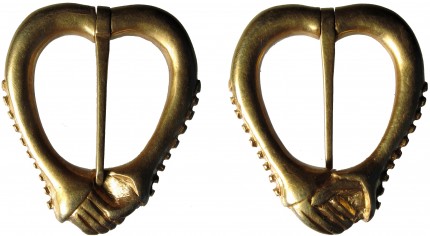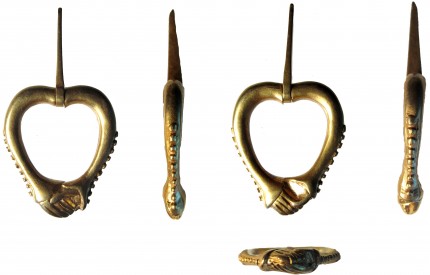Last June 11th, metal detector enthusiast Stan Cooper was exploring a spot by a stream in a farmer’s field near Sandbach, Cheshire when his machine signaled. He dug four or five inches down and discovered a small object that was so encrusted with dirt he couldn’t identify exactly what it was, but it seemed to him it was made of a precious metal. After ten minutes in an ultrasonic cleaner, the artifact revealed itself to be a small, exquisitely detailed gold brooch.
 Cooper has been metal detecting for 20 years, but he’s never found anything like this. It’s an annular (or ring style) brooch just a little bit larger than a pound coin. The outer frame is shaped like a heart and has a gold pin bisecting it vertically. The bottom half of the heart has been crafted in the shape of two be-sleeved lower arms that come together at the point with two clasped hands.
Cooper has been metal detecting for 20 years, but he’s never found anything like this. It’s an annular (or ring style) brooch just a little bit larger than a pound coin. The outer frame is shaped like a heart and has a gold pin bisecting it vertically. The bottom half of the heart has been crafted in the shape of two be-sleeved lower arms that come together at the point with two clasped hands.
The sleeves are decorated with studs along the edges, possibly meant to suggest buttons, that start larger up top and get smaller toward the wrist, but each sleeve is also different from the other. Looking at the brooch from the front, the left hand has a shorter sleeve that stops at the wrist, while the right sleeve covers the upper hand and is trumpet shaped. The length and style of the sleeves suggest that the right hand is female, the left male. The end of the pin fits in the palm of the male hand.

Cooper had two weeks to kill before having to report it to his local archaeological authority, so he did some research. He thought the workmanship identified it as pre-Victorian and discovered that the clasped hands design has been found from Roman-era pieces right through the medieval period.
He then turned it in to Peter Reavill of the Portable Antiquities Scheme who identified it as a high quality gold jewel from the late Middle Ages (1350-1450 A.D.), probably meant to be a betrothal gift. It is unique. Heart shaped brooches have been found dating to the later Middle Ages. The combination of the heart shape with the clasped hands is most unusual, and no other brooches have been found with the three distinctive elements adorning this one: the heart shape, the hands and the detailed sleeves.
He designated it a find of regional importance and it was sent to the British Museum for examination and authentication. They confirmed its medieval dating and treasure status. At this point, the Crown has the opportunity to claim the piece for the national patrimony. A coroner’s inquest ensues to declare it treasure, determine the market value and offer it for purchase to local and national museums who might want to add it to their collections. In this case, however, the Crown disclaimed it as treasure, probably because no museum vied for the small piece, and thus it has been returned to Stan Cooper.
He is putting it up for auction at Adam Partridge Auctioneers & Valuers in Macclesfield, Cheshire. The pre-sale estimate is £25,000 (ca. $40,000). Cooper will share all proceeds from the sale with the farmer who owns the field in which the lovely little treasure was found.
